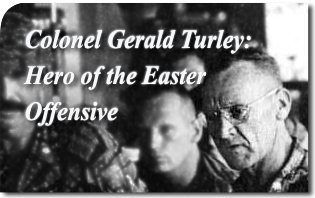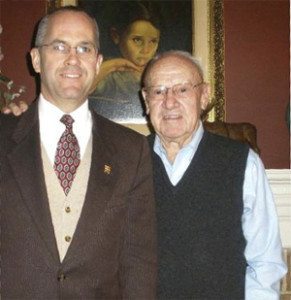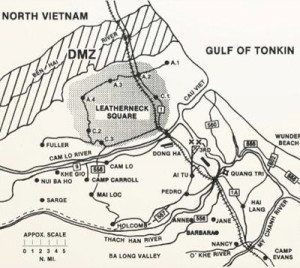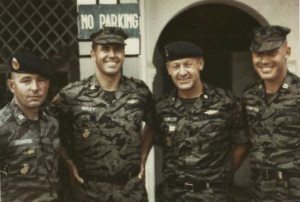 The history of the twentieth century saw the spread of communism the world over and the virtual river of blood left in its wake was unprecedented. Communist expansion was greatly facilitated in the West through subtle psychological maneuvers and a policy of appeasement which weakened the anti-communist’s will to resist.
The history of the twentieth century saw the spread of communism the world over and the virtual river of blood left in its wake was unprecedented. Communist expansion was greatly facilitated in the West through subtle psychological maneuvers and a policy of appeasement which weakened the anti-communist’s will to resist.
From ping pong matches with China to baseball games in Cuba, Western leaders carried out a foolishly optimistic approach to the advancing red wolf. While communist leaders conquered vast territories at gun point — putting hundreds of millions to death in the process — those same optimists dreamed of disarming the enemy with conciliatory smiles and concessions (a policy which continues until today).
That dream was proven to be a nightmare forty years ago when a handful of brave South Vietnamese soldiers and American servicemen faced and ultimately repelled the largest communist onslaught of the entire Vietnam War. It was all made possible through fortuitous circumstances which placed Colonel Gerald Turley, then a Marine Corps Lieutenant Colonel, in a crucial position of authority for four adventurous days. His fearless decision making and intestinal fortitude turned certain defeat into a stunning victory and prevented a humiliating outcome for American forces.
First Salvos of the Easter Offensive
At the height of the Vietnam War in 1968, there were over 500,000 American servicemen in the country. Over the next years that number would be drastically reduced when President Richard Nixon took office in January of 1969. His Vietnamization program was aimed at getting American troops out of the country and turning the war over to the Vietnamese.

In the following years massive amounts of Soviet and Chinese weaponry made its way to North Vietnam. This included Soviet MiG aircraft, T-54, T-55 and PT-76 Russian tanks, Surface to Air (SAM) and heat-seeking missiles and an abundance of 130 MM to 152MM artillery.1
In March of 1972 there were only 50,000 American servicemen in the country. The imminent withdrawal of American support and the buildup of armaments in the North proved to be demoralizing to the South Vietnamese anti-communist resistance. They had good reason to be discouraged.
However, what the Vietnamese did not realize at that time, was the quality of the American advisors who returned to help. One of those men was Colonel Gerald Turley. He had already served in the Korean War and had now voluntarily returned to Vietnam for a second tour of duty in a war that was becoming more unpopular by the day.
On Wednesday March 29, only days after arriving in the country, Colonel Turley was in the middle of a four-day trip visiting the firebases, along the Demilitarized Zone (DMZ). He spent the night at the 3rd ARVN (Army of the Republic of Vietnam) Division Headquarters in the AI TU combat base, located five miles south of the Dong Ha village.

The following morning was spent in briefings followed by lunch. When he stepped out of the dining tent the area was suddenly struck by intense artillery fire. It was the first salvos of the historic battle that would come to be known as the Easter Offensive.
“So many artillery shots were going off,” said Colonel Turley, “you could not distinguish one from the other.” 2 Before the sun set that day, over 11,000 rounds3 rained down on the South Vietnamese firebases and surrounding villages in the northern part of Quang Tri province; and more was to come.
The Hunted Become the Hunters
For eighteen hours the South endured a hellish barrage. On the morning of March 31, the Army Colonel in charge of the 3rd ARVN Division began to suffer from combat fatigue. He eventually approached Colonel Turley with a surprising request.
“Would you mind taking over here for a couple of hours,” he asked.
“I am Marine and am only here as an advisor,” Colonel Turley replied. “I can’t do that.” When the Army Colonel insisted, Colonel Turley asked for his name and Social Security number which he quickly scribbled down on a piece of paper. This seemingly insignificant incident made Colonel Turley the Senior Advisor in charge of the entire 3rd ARVN Division and changed the course of the battle. For the next four days he made numerous critical decisions which ultimately broke the back of the adversary.
His task would not be an easy one however. His newly acquired area of responsibility spanned the five northernmost provinces of South Vietnam. Between his location in the Command and Control bunker (COC) and the DMZ was twelve firebases manned by South Vietnamese Marines and their American advisors. Over the next days ten of those firebases, including Camp Carroll with its 1,500 troops and twenty-six artillery pieces, fell into enemy hands that were advancing in a three pronged attack.
By Easter Sunday over thirty thousand civilians were making their way down Highway 1 in a desperate attempt to flee the wrath of the adversary. Communist NVA artillery fire was strategically placed right on top of them. Those surviving the deadly rounds melted back into the masses and kept moving. South Vietnamese soldiers, seeing the futility of resistance, removed their military insignias and blended in with the frenzied mob.
 Learn All About the Prophecies of Our Lady of Good Success About Our Times
Learn All About the Prophecies of Our Lady of Good Success About Our Times
“It was absolutely the worst scene I have ever witnessed,” said Colonel Turley,4 his words trailing off as if the image was too painful to revisit.
The NVA, seeing the South’s weakness, exploited it to the maximum degree and began an unhindered advance towards the Dong Ha Bridge with 30,000 troops and 200 tanks. They were in for a big surprise upon their arrival. The brave men of the 3rd Division under Colonel Turley’s leadership were about to turn the tables. From being hunted, they were about to become the hunters.
Caught In the Cross Hairs of Naval and Air Gunfire
Colonel Turley, who was personally given a carte blanche for B-52 strikes in I CORPS by an Air Force Lieutenant General, ordered over fifty such missions.5 He then ordered the 3rd ARVN Division to commit its reserve Battalion, the famed “Soi Bien” or Sea Wolves, commanded by Major Le Ba Binh, and legendary Marine Corps Captain (later Colonel) John Ripley. It was the equivalent of playing ones last card.
Leaders in the Army Regional Headquarters at Da Nang, eighty miles south from AI TU, did not realize the gravity of events along the DMZ. They ordered Colonel Turley not to blow the bridge since it would be useful for a counter offensive. Colonel Turley knew there would be no counter measure if the bridge was left standing and courageously ordered Colonel Ripley to destroy it.6
With the Dong Ha bridge in flames NVA tanks made a futile rush for the Cam Lo bridge west of the city. Their elongated column provided a perfect target for Naval Gunfire from the USS Buchanan sitting in the Gulf of Tonkin and the B-52 strikes which Colonel Turley had requested hours earlier. The column of Russian tanks was now caught in the cross hairs of naval and air gunfire.

“When the thundering noise and the violent shock waves of the 250 or more bombs… finally subsided, [Colonel] Ripley reported ‘hearing the cries of the survivors, but no more engine noises.’”7
“…Continue Naval Gunfire”
Later in the afternoon of that same day another problem developed when an EB-66 Electronic intelligence aircraft was shot down. The only survivor, Lieutenant Colonel Iceal Hambleton, was a ballistic missile expert with top secret clearance.8
The Air Force called for a cease fire in a seventeen-mile-radius of the downed pilot which practically encompassed the entire area of operations of the 3rd. Division.9 When an American Jolly Green HH-53 helicopter tried to rescue the pilot it was struck by a SAM Missile and burst into flames. Ten more aircraft were lost during the eleven-day rescue mission.
Once again Colonel Turley would have to go directly against orders from higher command. To stop firing would have spelled certain defeat and he was not about to lose this battle.
“Fully realizing the fragile defensive posture of the 3rd Division and the seriousness of again violating a direct order,” Colonel Turley said, “I authorized the advisors to commence their pending fire mission.”10
It was decided that a three mile radius around Lieutenant Colonel Hambleton was a sufficiently safe distance. In an act of selflessness Colonel Turley accepted full responsibility for the pilot’s safety and directed Lieutenant Joel Eisenstein in the COC to continue coordinating naval gunfire with the USS Buchanan.
No More Ping Pong Games
The Easter Offensive continued through the rest of April. However, the communists were simply unable to overcome the devastating blow given to them by a Marine Corps Lieutenant Colonel who just happened to be in the right place at the right time. They were finally halted just outside Quang Tri City on May 1st. Thus the fall of South Vietnam to Communism was delayed for a full three years and more importantly, America, the anti-communist bulwark in the world, was saved from a humiliating defeat.
It would be an exaggeration to say Colonel Turley’s actions alone are what halted the Easter Offensive. There were many brave men who fought and some who gave the full measure during those fateful days. However, there is a striking difference between Colonel Turley’s actions and theirs. If they survived they could only expect awards and praise — which they richly deserved — whereas Colonel Turley knew that he would likely receive reprimand, scorn and possibly jail time for his perceived insubordination.
It is for this reason that Colonel Turley is truly the hero of the Easter Offensive. He chose to make war against communism at a time when so many others simply preferred to play games and smile.
Footnotes
- Colonel Gerald H. Turley, USMC (Ret.) The Easter Offensive: The Last American Advisors, Vietnam 1972 (Annapolis, Md.: US Naval Institute Press, 1995) p. 27.
- Comments made during a lecture Colonel Turley gave at the headquarters of the American Society for the Defense of Tradition, Family and Property (TFP) in Spring Grove, Pennsylvania. Hereafter referred to as TFP Lecture.
- Colonel Gerald Turley, p. 66.
- TFP Lecture.
- From an official report about the Easter Offensive, prepared by Colonel Turley, for the purpose of getting Colonel John Ripley’s Navy Cross upgraded to the Medal of Honor.
- The details of this daring feat, for which Colonel John Ripley earned the Navy Cross, are narrated in his biography, An American Knight: The life of Colonel John Ripley USMC.
- Colonel Gerald Turley, p. 205.
- http://en.wikipedia.org/wiki/Iceal_Hambleton.
- Dale Andrade, America’s Last Vietnam Battle: Halting Hanoi’s 1972 Easter Offensive (University Press of Kansas) p. 76.
- Colonel Gerald Turley, p. 203.
